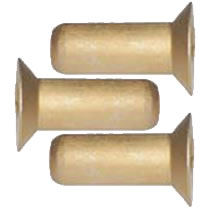
Rivets are commonly used in the aerospace industry to secure two or more parts together. They are permanent fasteners that, once installed, won’t loosen due to vibrations or other external forces. While most rivets feature a cylindrical body, though, they are available in different types. Here are five common types of rivets you need to know.
#1) Solid
Of all the different types of rivets, solid rivets are the most common. As shown in the photo above, they are characterized by a solid cylindrical body. Solid rivets are installed in pre-drilled holes. They are designed to partially collapse or deform during installation. When this occurs, the solid rivet becomes permanently affixed in the hole, thereby holding the parts together.
#2) Blind Rivets
Blind rivets are characterized by a hollow cylindrical body. They are used in fastening applications where you only have access to one side of the parts. If you can only access the front of the parts, for instance, you may want to use a blind rivet to secure the parts together. They are known as “blind rivets” because they only require access to a single side of the parts, such as the front or back of the parts.
#3) Field
There are field rivets as well. Also known as 2117-T rivets, they fall under the category of solid rivets. Field rivets feature a solid cylindrical body — just like all solid rivets. Field rivets, however, are made of aluminum. You can install field rivets using a hammer or a rivet tool.
#4) Tubular
You may come across tubular rivets when shopping for rivets. They feature a tubular design. Tubular rivets look like elongated solid rivets. They still have a cylindrical body, but the body is longer than that of a solid rivet. Furthermore, the body of a tubular rivet is only partially solid. The tip (opposite to the head) is hollow, whereas the rest of the body is solid. When installing a tubular rivet, the hollow end should protrude out of the parts with which you use it.
#5) Self-Piercing
There are self-piercing rivets. Self-piercing rivets eliminate the need for creating a hole before installation. With most other types of rivets, you’ll need to create a hole in the parts so that you can drive the rivet through the parts. Self-piercing rivets, though, don’t require a precut or predrilled hole. They will create a hole automatically by piercing the parts with a sharp point.



